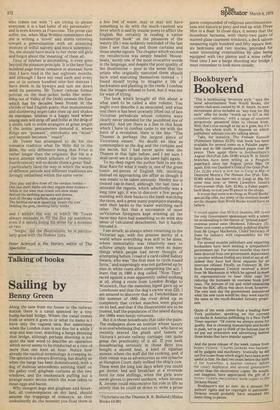Talking of books
Sailing by
Benny Green
Along the lane from my house to the railway station there is a canal spanned by a tiny hump-backed bridge. Where the canal comes from or where it goes to or what its name is I have only the vaguest idea. But sometimes when the London train is not due for a while I stop and lean over, watching a barge shooting that bridge, although perhaps shooting is not quite the best word to describe an operation which never seems to be conducted at a rate of more than one knot an hour. Notice how already the nautical terminology is creeping in. The spectacle is always diverting, but doubly so when the barge has been domesticated, with a dog of dubious antecedents sunning itself on the galley roof, gingham curtains at the tiny windows, and the "smokestack puffing out a strange exotic device which the nose takes to mean eggs and bacon.
Why mongrel dogs and gingham and breakfast, all commonplaces on dry land, should assume the trappings of romance, as they undoubtedly do, the moment you float them in a few feet of water, may or may not have something to do with the much-vaunted sea fever which is said by insular poets to afflict the English. But certainly in reading a rather nondescript book* on the pleasures of the watery life I was suddenly reminded of the last time I saw that dog and those curtains and those smoke signals. The chapter which excited my recollections was simply headed 'Houseboats,' surely one of the most evocative words in the language, and despite the poor quality of the illustrations — poor in the sense that the artists who originally executed them should have tried executing themselves instead — I found myself trying to imagine a life of backwaters and plashing in the reeds. I confess that the images refused to form, but it was not for want of trying.
The book which brought all this about is what used to be called a slim volume. You might even describe it as emaciated, and what text there is has been unwisely lifted out of late Victorian periodicals whose columns were clearly never intended for the jaundiced eye of posterity. And yet there is a line in this book which I have to confess came to me with the force of a revelation. Here is the line: "The Thames is perhaps the largest piece of Victoriana extant." No doubt an idea as commonplace as the dog and the curtains and the bacon, but I had never quite seen the Thames in that light before, and I am sure I shall never see it in quite the same light again. To my deep regret the author fails to see the Boat Race for what it really is, one of the great Comic set-pieces of English life, insisting instead on approaching the affair as though it was meant to be taken seriously. Henley too is treated cap-in-hand, although the last time I attended the regatta, which admittedly was a long time ago, it was to discover a few people standing with their backs to the bank watching the races, and a great many popinjays standing with their backs to the water watching each other. The fact that a succession of most unVictorian foreigners kept winning all the races may have had something to do with this sense of calculated detachment, but it hardly excused it.
I am struck, as always when returning to the Victorian age, with the pristine purity of a world where everything was still to be done, where immortality was relatively easy to achieve simply because there were so many things which people had never thought of attempting before. I read of a card called Sidney Swann, who was "the first man to cycle round Syria," and surprisingly was not gathered up by men in white coats after completing the act; I learn that in 1880 a dog called "Now Then" raced against a man apparently called nothing at all, along a route from London Bridge to Woolwich, that the nameless biped gave up at Limehouse and that the dog's owner won £25; I am amazed to discover that at Twickenham in the summer of 1885 the river dried up so completely that cricket matches were played on its bed, and that if the illustrations are to be trusted, half the population of the island during the 1880s were banjo virtuosos.
But it is those houseboats that take the palm. The endpapers show an interior whose luxury is so overwhelming that not even I, who have so recently braved the plush and tassels of Victoria's private railway carriage, can quite grasp the practicality of it all. If you took houseboating seriously in those days you bought a second boat, a kind of riparian annexe, where the staff did the cooking, and, if their owner was as adventurous as one sybarite at Hampton Court, daily milked the ship's cow. These were the long lost days when you could get dinner, bed and breakfast at a riverside hotel for nine shillings, when the girls wore suede gloves to prevent sunburn, when Jerome K. Jerome could misconceive his role in life so utterly that he could sit down to write a prose *Victorians on the Thames R. R. Bolland (Midas Books £4.00) poem compounded of religious sanctimoniousness and historical piety and end up with Three Men in a Boat. In those days, it seems that the houseboat Satsuma, with thirty-two pairs of stained-glass casement windows, a deck saloon measuring eight hundred and fifty square feet, six bedrooms and two stories, provided for some interesting eventualities by also being equipped with two pianos and a wine cellar. Next time I see a barge shooting our bridge I must remember to look more closely.










































 Previous page
Previous page